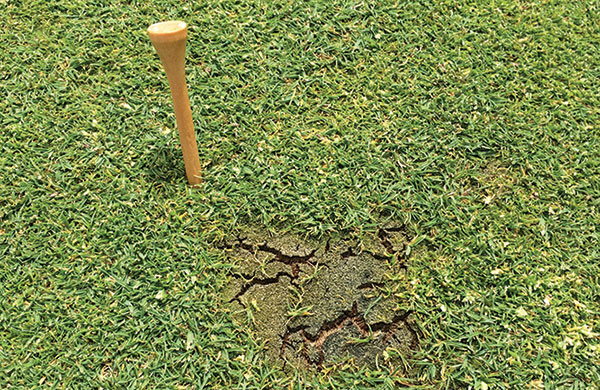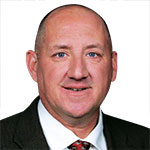Experts’ Insights: Suppressing silvery thread moss

Photo: Zane Raudenbush
Silvery thread moss easily can be spotted in putting greens by its silvery sheen, according to Zane Raudenbush, Ph.D., assistant professor of turfgrass management at Ohio State University.
Raudenbush adds that it’s particularly persistent in creeping bentgrass or annual bluegrass putting greens, especially in greens with constructed or man-made sand-based root zones.
“Once you allow silvery thread moss to get into a putting green, you’re going to have to use an array of tools to get it out and keep it controlled,” Raudenbush says.
Reevaluating irrigation practices is one way to keep silvery thread moss at bay.
“The survival of moss is so dictated by the availability and persistence of water because it is just like a sponge,” Raudenbush says. “So, any time you’d think of rainwater or irrigation water that rehydrates the sponge, that’s when moss would be actively photosynthesizing.”
Because a colony the size of a quarter may boast up to 1,000 threadlike shoots, Raudenbush also recommends being wary that equipment — and even golfers’ shoes — can track the silvery thread moss from green to green.
“Things like brushing, verticutting, basic mowing, especially at low cutting heights, are going to help disperse some of those moss shoots,” he says.
In some cases, superintendents can physically remove the moss with a cup cutter, dispose of the plugs and use their nursery plugs to reestablish the area.
Making use of herbicides with the active ingredient of pyraflufen-ethyl or carfentrazone-ethyl is another piece of the puzzle to fend off the disease.

Tina Bond (Photo: FMC Professional Solutions)
FMC Professional Solutions
Tina Bond
Technical service manager
Silvery thread moss (Bryum argenteum) is a perennial, nonvascular plant that spreads by spores, fragmentation or bulbils. It typically can be seen growing in greens in small patches that have a silver-green sheen and texture. It is highly adaptive and can survive some of the harshest conditions. Spores may be spread by equipment, surface water drainage and even by golfers. With its spongelike appearance and texture, silvery thread moss can retain an enormous amount of water and survive on extremely little water. It often appears in voids in the turf; therefore, we always recommend maintaining healthy, dense turf. It’s important to irrigate infrequently, but thoroughly enough to encourage turf root growth deep into the soil. Raising mowing heights has shown to decrease its severity. Increasing nitrogen levels will promote turfgrass growth. Rolling, aerification and topdressing can help reduce the incidence of silvery thread moss. Superintendents can make QuickSilver applications when turf actively is growing so it can fill in voids left by the moss.

Scott Schurman
LaFortune Park Golf Course
Scott Schurman
Golf course superintendent
We deal with (silvery thread moss) a bit at LaFortune Park GC, but the majority of what I’ve dealt with was in Carney, Neb. Originally, we’d take a weed wand — it’s a tube — it’s got a little sponge on the end and a spring. We’d daub the greens out a bit, and we were having good luck with it. A few years later, I took a webinar, and it mentioned that if you have silvery thread moss on one green, you have it on all of them because the spores get on the rollers and spread. We started blanket spraying 2 ounces per acre of QuickSilver once a month. When we were using it in the summer months, we also added TrimIt to the tank mix, and that would help encourage the bentgrass to spread and start covering over the dead spots of the silver thread. We’d start treating it in early April or late May and treat it all the way through September.

Tom Woodward
Bayonne Golf Club
Thomas Woodward
Golf course superintendent
We’ve pretty much always had a moss problem on the greens, and it fluctuates. Some years it’s pretty minor and others it’s pretty severe — a lot of that depends on the weather, how much rain we’re getting, how much cloud cover we’re getting. Wet, cloudy weather really seems to help it grow and spread. We do a light topdressing once or twice a month and try to restrict irrigation. The best irrigation practices are deep and infrequent. We typically spray QuickSilver periodically throughout the year if we start seeing it flare up. It’s better to do it on a sunny day. Aerification to break up the moss pads also helps, anything you can do to break up the pad of the moss to try and get the bentgrass to grow through it. Something else I think is key is spraying the QuickSilver somewhere between three to seven days before you do major cultural practices like aerification and verticutting, so you’re not spreading those spores all over.

Rodney Robins
The Country Club at Muirfield Village
Rodney Robins
Golf course superintendent
I’m in my third season at The Country Club at Muirfield Village, and one of the first things I noticed when I got here is that I had three greens that had really bad moss. I had some golf-ball- to baseball-sized patches. What we had was beyond what we could chemically control. I’ve been extremely aggressive with just plugging it out with the cup cutter. We just physically remove it. We looked at the reasons why we have moss here. We’ve taken corrective actions on all of those. I had poor irrigation coverage that was overwetting areas. I had some shade issues with some trees; I wasn’t getting any direct sunlight until 10 or 11 a.m. We’re pretty much now just using the QuickSilver. I’ll do three sprays three weeks apart at 2 ounces per acre. We’ve stopped the bleeding and started recovering all of these areas. I treat with QuickSilver across all the greens when I do the application. I add ammonium sulfate at 21-0-0; it helps pull the QuickSilver into the plant.










